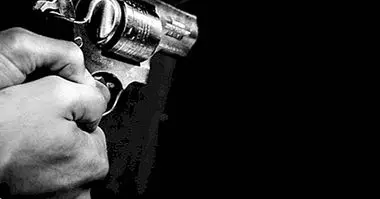How to make a genogram in psychotherapy
In clinical practice, obtain information about the patient , the problem for which he comes to consultation and the circumstances surrounding that problem or can influence it is a fundamental part of the psychotherapeutic process. The psychologist needs this information to be able to work and contribute to address the issues that the patient poses, serving as a guide through the process .
Within this information, understand the family structure and the type of relationships that the subject maintains with their closest environment It can help greatly to understand the current situation of the subject. The obtaining of this information is carried out through different methods, being able to register in a simple and easily comprehensible form if a genogram is elaborated.
- Maybe you're interested: "Types of psychological therapies"
What is a genogram?
We call a graphic representation genogram in which the general information about the constitution of a family is expressed and the interrelationships among its members. It is a schematic way of visualizing familiar patterns and the type of relationships that are established among its members. In a genogram, all the people who make up the family structure are reflected, both those who are still alive and those who have died or who have left the family nucleus. Abortions are also included. Although it usually goes back up to a total of three generations, this can vary according to the type of problem that motivates the psychologist.
The genogram not only reflects the family structure, but also serves to visualize the presence of very important and vital events for the subject, such as the birth of a brother , the death of a relative, a wedding, a divorce or an abortion. This type of events can greatly influence the human psyche and change the type of relationships that each individual of the family system has, including the client or patient, which may originate or contribute to the presence of disorders or problems linked to the reason for consultation. of the patient. That is why it is a tool widely used in clinical practice to analyze family relationships.
So, although the final result seems simple and simple, this type of representations offers a lot of information to the professional when it comes to understanding where the patient comes from and how their origins can help explain their present, allowing us to sketch different strategies and ways of acting.
- This article may interest you: "The 8 types of families and their characteristics"
Building a genogram
At first glance it may seem that developing a genogram is really quick and without any complication. However, to elaborate a meaningful genogram It is not enough to make a series of intertwined symbols : family composition and structure must be explored and taken into account while taking into account the effect that these relationships may have on the patient. In addition, although it is a graphic representation that could be constructed in very different ways, a series of symbols and steps have been established to make it understandable and practical.
To start building a genogram, first of all The objective with which the representation is carried out must be taken into . Given that a family can be made up of a large number of people, it is necessary to delimit the type of relationships that must be reflected, delimiting the representation to those closest to or linked to the problem. Let's see next the steps to take in the elaboration of the genogram.

1. Construction of the basic structure
In the first moment we proceed to outline the basic structure of the family . Thus, at this point each of the members of the family is represented through a figure and the link that unites them from lines that unite the components of the system. Basically a genealogical tree is made centered on the client or patient and their closest relatives, generally limiting themselves to assessing a total of three generations including that of the above mentioned.
In addition, a genogram not only indicates who is part of a family but also which members of said family coexist in the same location with the client or patient , for which it is surrounded with a discontinuous line to all the members of the family that cohabit with him. This helps to understand who has the most contact with the patient and how this contact affects their lives.
2. Basic data collection of the subjects
Once the structure of the genogram is drawn and the main people and relationships are represented, it is necessary to understand the functioning of the family collect various general data .
For example, age, educational level and socio-employment and the profession of close beings can affect the development of the subject, so having these data allows to improve the understanding of the system. It is also useful to know the presence of a history of mental or medical disorders.
3. Marking what type of relationship they maintain
In addition to knowing who is who and the most basic vital data, it is necessary observe the type of relationships and the emotional involvement that these have , given its importance at the time that the client interprets interpersonal relationships and even reality.
With this we can observe, among other things, if there are conflicting or very close relationships that serve as support or as a risk factor to promote an improvement or worsening of the patient's situation.
Symbology and its meaning
Regardless of the process that is followed during the construction of the genogram, it is important to understand what symbols are used in each situation.
It must be taken into account that what is symbolized is not only to each member of the family, but also the type of link that links it to the rest of the components.
Symbolizing people
When analyzing or creating a genogram, we must consider what or to whom one of the symbols is being represented. Each individual of the family is represented with a single symbol. Specifically, we will use the outline of a square when we refer to a man and that of a circle when we are representing a woman . Inside the symbol will appear the current age of the subject if it is alive, above it the year of birth and just below the symbol the name of the individual. When representing the client or patient, the figure that represents it is double (that is, a square or center circle of another). If the person being represented is someone who has already passed away, we will find that the symbol is crossed out, with an X on top.
Other symbols to have are those referred to the presence of abortions . In this aspect we find two symbols depending on whether the interruption of the pregnancy has been voluntary or accidental: in the first case a small X will be used without this being crossed out any symbol, while in case of spontaneous abortion a small circle completely painted.
In the case that it is necessary to assess the sexual orientation of one of the family members to understand the reason for the patient's consultation (for example, if a patient with problems to accept the sexual orientation of a family member comes to consultation), indicate if the subject belongs to the LGTB collective with an inverted triangle inside the symbol that indicates their sex .
The fact that the symbols are only a contour or are more or less filled has also certain implications. Subjects who consume and abuse substances such as alcohol and drugs will have half of their symbol painted, horizontally. If the individual suffers mental problems, the symbol will have half painted, but in this case vertically . If both psychiatric problems and substance abuse are added, three quarters of the symbol will be painted.
Representing family relationships
Apart from the subjects, the type of relationship that each component has with the rest is also reflected in the genogram. In this sense we are also with different representations in connections between subjects .
The marital union between two people is symbolized by a straight and continuous line, the two individuals being at the same height. If two people have a relationship but are not married, this relationship will be represented with a discontinuous line, also being at the same height. If the couple separates, a diagonal bar will cut the line that joins them, marking the year of the break. In the case of a divorce we will find two diagonal bars . In the event that a divorced or separated couple subsequently rejoins, the bars marking their separation will be crossed out.
The presence of children is symbolized by lines that emerge from the union of two people , being the continuous line in the case of biological children and discontinuous if we are before an adopted child. If it is more than one shoot, they will be ordered from left to right depending on the age.
The presence of brothers presents some characteristics to take into account . If we are before twins, the lines that represent the union with the parents will emerge from the same point. Otherwise, the lines will be born in different points from the one indicated by the link between both parents.
Indicating the type of relationship
The type of structural linkage maintained by family members has been indicated so far, but it is also possible indicate how this relationship is emotionally related .
Positive and normative relationships will be marked while both are subject to exactly the same height.A distant relation can be marked while both subjects are at different heights, both symbols not being linked at the same point. Conflicting relationships will be indicated by zigzagging lines , and in case of the presence of physical or psychic abuses this situation will be represented with a zigzag line that will end in an arrow that will indicate in which direction the abuse is going.
An intimate relationship can be indicated from two lines instead of one. while merged relationships will be marked with three lines. Combinations can be made from these constructions.
- Related article: "Toxic families: 4 ways in which they cause mental disorders"
Bibliographic references:
- Compañ, V .; Feixas, G .; Muñoz, D. and Montesano, A. (2012) - The genogram in systemic family therapy. University of Barcelona. Departament de Personalitat, Avaluació i Tractament Psicològics. Faculty of Psychology
- McGoldrick, M. and Gerson, R. (1985) Genograms in family evaluation. Barcelona: Gedisa (3rd edition, 2000).



















